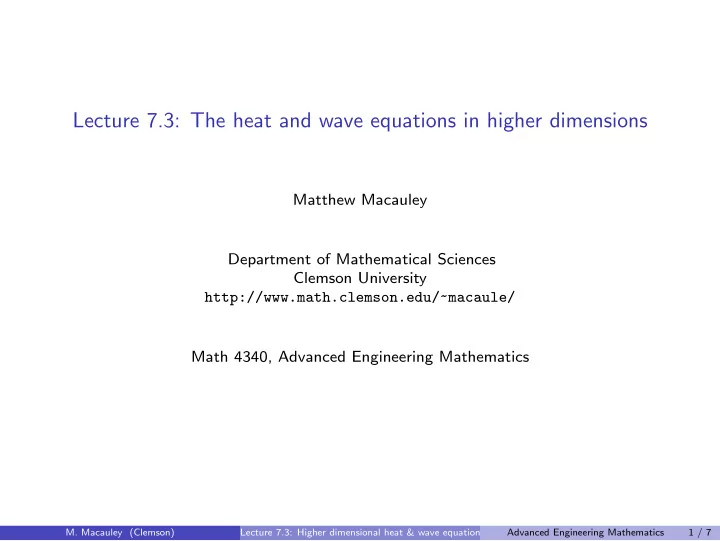

Lecture 7.3: The heat and wave equations in higher dimensions Matthew Macauley Department of Mathematical Sciences Clemson University http://www.math.clemson.edu/~macaule/ Math 4340, Advanced Engineering Mathematics M. Macauley (Clemson) Lecture 7.3: Higher dimensional heat & wave equations Advanced Engineering Mathematics 1 / 7
Overview Three fundamental PDEs in R n Laplace’s equation: ∆ u = 0 Heat equation: u t = c 2 ∆ u Wave equation: u tt = c 2 ∆ u Non-Dirichlet and inhomogeneous boundary conditions are more natural for the heat equation. Solving the heat equation To solve an B/IVP problem for the heat equation in two dimensions, u t = c 2 ( u xx + u yy ): 1. Find the steady-state solution u ss ( x , y ) first, i.e., solve Laplace’s equation ∆ u = 0 with the same BCs. 2. Solve the related heat equation with homogeneous boundary conditions. Add these two together to get the solution: u ( x , y , t ) = u ss ( x , y ) + u h ( x , y , t ). M. Macauley (Clemson) Lecture 7.3: Higher dimensional heat & wave equations Advanced Engineering Mathematics 2 / 7
Homogeneous boundary conditions Example 1a Solve the following IVP/BVP for the 2D heat equation: u t = c 2 ( u xx + u yy ) , u (0 , y , t ) = u ( x , 0 , t ) = u ( π, y , t ) = u ( x , π, t ) = 0 u ( x , y , 0) = 2 sin x sin 2 y + 3 sin 4 x sin 5 y . M. Macauley (Clemson) Lecture 7.3: Higher dimensional heat & wave equations Advanced Engineering Mathematics 3 / 7
Inhomogeneous boundary conditions Example 1b Solve the following IVP/BVP for the 2D heat equation: u t = c 2 ( u xx + u yy ) , u (0 , y , t ) = u ( x , 0 , t ) = u ( π, y , t ) = 0 , u ( x , π, t ) = x ( π − x ) u ( x , y , 0) = u ss ( x , y ) + 2 sin x sin 2 y + 3 sin 4 x sin 5 y . M. Macauley (Clemson) Lecture 7.3: Higher dimensional heat & wave equations Advanced Engineering Mathematics 4 / 7
The wave equation The set-up Consider a vibrating square membrane of length L , where the edges are held fixed. If u ( x , y , t ) is the (vertical) displacement, then u satisfies the following B/IVP for the wave equation: u tt = c 2 ( u xx + u yy ) , u ( x , 0 , t ) = u (0 , y , t ) = u ( x , L , t ) = u ( L , x , t ) = 0 u ( x , y , 0) = h 1 ( x , y ) , u t ( x , y , 0) = h 2 ( x , y ) . The functions h 1 ( x , y ) and h 2 ( x , y ) are initial displacement and velocity, respectively. M. Macauley (Clemson) Lecture 7.3: Higher dimensional heat & wave equations Advanced Engineering Mathematics 5 / 7
Finding the general solution Example 2 Solve the following IVP/BVP for the wave equation: u tt = c 2 ( u xx + u yy ) , u ( x , 0 , t ) = u (0 , y , t ) = u ( x , π, t ) = u ( π, x , t ) = 0 u ( x , y , 0) = x ( π − x ) y ( π − y ) , u t ( x , y , 0) = 0 . M. Macauley (Clemson) Lecture 7.3: Higher dimensional heat & wave equations Advanced Engineering Mathematics 6 / 7
Solving the resulting IVP Example 2 (cont.) The general solution to the following IVP/BVP for the wave equation: u tt = c 2 ( u xx + u yy ) , u ( x , 0 , t ) = u (0 , y , t ) = u ( x , π, t ) = u ( π, x , t ) = 0 u ( x , y , 0) = x ( π − x ) y ( π − y ) , u t ( x , y , 0) = 0 . ∞ ∞ � � � m 2 + n 2 t ). is u ( x , y , t ) = b mn sin mx sin ny cos( c m =1 n =1 M. Macauley (Clemson) Lecture 7.3: Higher dimensional heat & wave equations Advanced Engineering Mathematics 7 / 7
Recommend
More recommend